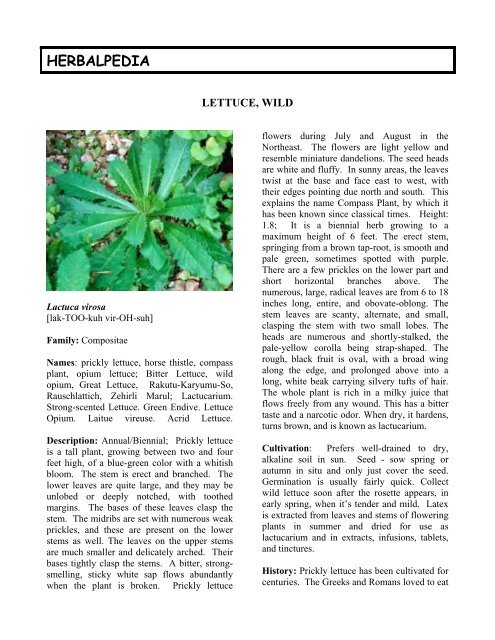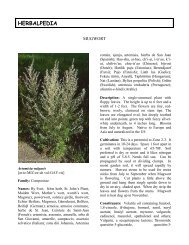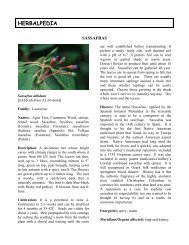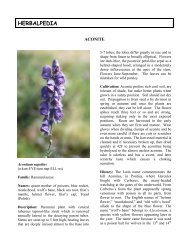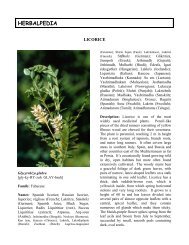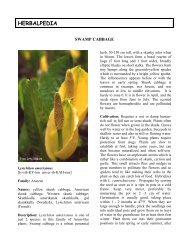You also want an ePaper? Increase the reach of your titles
YUMPU automatically turns print PDFs into web optimized ePapers that Google loves.
HERBALPEDIALETTUCE, WILD<strong>Lactuca</strong> <strong>virosa</strong>[lak-TOO-kuh vir-OH-suh]Family: CompositaeNames: prickly lettuce, horse thistle, compassplant, opium lettuce; Bitter Lettuce, wildopium, Great Lettuce, Rakutu-Karyumu-So,Rauschlattich, Zehirli Marul; <strong>Lactuca</strong>rium.Strong-scented Lettuce. Green Endive. LettuceOpium. Laitue vireuse. Acrid Lettuce.Description: Annual/Biennial; Prickly lettuceis a tall plant, growing between two and fourfeet high, of a blue-green color with a whitishbloom. The stem is erect and branched. Thelower leaves are quite large, and they may beunlobed or deeply notched, with toothedmargins. The bases of these leaves clasp thestem. The midribs are set with numerous weakprickles, and these are present on the lowerstems as well. The leaves on the upper stemsare much smaller and delicately arched. Theirbases tightly clasp the stems. A bitter, strongsmelling,sticky white sap flows abundantlywhen the plant is broken. Prickly lettuceflowers during July and August in theNortheast. The flowers are light yellow andresemble miniature dandelions. The seed headsare white and fluffy. In sunny areas, the leavestwist at the base and face east to west, withtheir edges pointing due north and south. Thisexplains the name Compass Plant, by which ithas been known since classical times. Height:1.8; It is a biennial herb growing to amaximum height of 6 feet. The erect stem,springing from a brown tap-root, is smooth andpale green, sometimes spotted with purple.There are a few prickles on the lower part andshort horizontal branches above. Thenumerous, large, radical leaves are from 6 to 18inches long, entire, and obovate-oblong. Thestem leaves are scanty, alternate, and small,clasping the stem with two small lobes. Theheads are numerous and shortly-stalked, thepale-yellow corolla being strap-shaped. Therough, black fruit is oval, with a broad wingalong the edge, and prolonged above into along, white beak carrying silvery tufts of hair.The whole plant is rich in a milky juice thatflows freely from any wound. This has a bittertaste and a narcotic odor. When dry, it hardens,turns brown, and is known as lactucarium.Cultivation: Prefers well-drained to dry,alkaline soil in sun. Seed - sow spring orautumn in situ and only just cover the seed.Germination is usually fairly quick. Collectwild lettuce soon after the rosette appears, inearly spring, when it’s tender and mild. Latexis extracted from leaves and stems of floweringplants in summer and dried for use aslactucarium and in extracts, infusions, tablets,and tinctures.History: Prickly lettuce has been cultivated forcenturies. The Greeks and Romans loved to eat
it, and it was a popular “sallet” green during theMiddle Ages. Wild lettuce was called<strong>Lactuca</strong>rium, from the Latin word meaning“milky.” The leaves were reputedly thirstquenching, and the sap was believed to have asoothing, sleep producing effect and specialcurative powers. The Roman EmperorAugustus became convinced that a medicine oflettuce saved his life when he lay near death,and in gratitude and admiration he caused astatue and altar to be erected in the plant’shonor. In Assyrian herbal medicine, lettuceseeds were reportedly used with cumin as apoultice for the eyes. The name lactuca isderived from the classical Latin name for themilky juice, <strong>virosa</strong>, or 'poisonous.' All lettucespossess some of this narcotic juice, <strong>Lactuca</strong><strong>virosa</strong> having the most, and the others in thefollowing order: L. scariola, or Prickly Lettuce,L. altissima, L. Canadensis, or Wild Lettuce ofAmerica, and L. sativa, or Garden Lettuce.Cultivation has lessened the narcotic propertiesof the last, but it is still used for making alotion for the skin useful in sunburn androughness. The Ancients held the lettuce inhigh esteem for its cooling and refreshingproperties.Constituents: the latex known as lactucariumcontains lactucopicrin, lactucerin, lactucone,lactucin and lactucic acid. The leaves contain inaddition traces of a mydriatic alkaloid,flavonoids and coumarins.Medicinal Uses: The drug resembles a feebleopium without its tendency to upset thedigestive system. It is used to a small extent asa sedative and narcotic. Dissolved in wine it issaid to be a good anodyne. It’s said thattwenty-three out of twenty-four cases of dropsywere cured by taking doses of 18 grains to 3drachms of extract in twenty-four hours. It isused in Germany for this complaint, butcombined with more active drugs. It is said tobe also a mild diaphoretic and diuretic, easingcolic, inducing sleep and allaying cough.Water distilled from lettuce (eau de laitre) isused in France as a mild sedative in doses of 2to 4 oz., and the fresh leaves boiled in water aresometimes used as a cataplasm. Dosages ofpowder, 10 to 20 grains or more. Of tincture,30 to 60 drops. Of alcoholic extract, 1 to 5grains. Of <strong>Lactuca</strong>rium, 5 to 20 grains. Of fluidextract leaves, ¼ to 1 drachm. Of syrup,U.S.P., 2 drachms. Tincture, U.S.P., 30 drops.Wild Lettuce helps to calm restlessnessand reduce anxiety; it also helps to induce sleepfor those experiencing insomnia. It has asedative effect on the respiratory system,beneficial for whooping cough andnervous/dry/irritating coughs. It may also helpto relieve birth pains, headaches, andmuscle/joint pains. Calms overactivity oroverstimulation and excitability in children. Itis also taken to treat coughs, often combinedwith herbs such as licorice. Wild lettuce isthought to lower the libido and may also beused to relieve pain.Combines well with Prunusin irritablecoughs: with Humulus, Scutellaria,Cypripedium and Passiflorain insomnia andwith Dioscoreaand Cimicifugaforrheumaticpains. The tea is cooling anddiaphoretic. People use the infusion for gastricspasms, fevers, and insomnia, and apply the sapto rashes, warts and acne. <strong>Lactuca</strong>rium is noteasily powdered, and is only slightly soluble inboiling water, though it softens and becomesplastic.Preparation: The easiest method is to dry theleaves and roots and smoke them in a largepipe. The commercial technique is to heat (notboil) the leaf in water for at least an 8 hourperiod. Then remove the liquid <strong>Lactuca</strong>rinegoes into solution with water. A heat lamp isplaced over the bowl of liquid and a fan is usedto drive the water out of the extraction. Theresult will be a blackish gum which can besmoked best with a waterpipe and hot torch.The gum should be rolled in small balls andsealed in plastic to prevent them from dryingout. The hotter the flame, the better.Toxicity: In large quantities, may causedrowsiness and can repress sex drive.
Cosmetic Uses: The juice from the stemsmakes an astringent skin lotion. It removesblemishes and soreness caused by sunburn orwind, leaving the face soft and smooth.Complexion Milk: Dissolve the juice of thewhole plant in a ½ pint of hot water in asaucepan; let cool. The water should be thickand milky. Apply to the face and to any partmade sore by sun or drying winds, to leave theskin soft and smooth and to take away soreness.HERBALPEDIA is brought to you by The Herb Growing &Marketing Network, PO Box 245, Silver Spring, PA 17575-0245; 717-393-3295; FAX: 717-393-9261; email: herbworld@aol.com URL:http://www.herbalpedia.com Editor: Maureen Rogers. Copyright 2007.All rights reserved. Material herein is derived from journals,textbooks, etc. THGMN cannot be held responsible for the validity ofthe information contained in any reference noted herein, for the misuseof information or any adverse effects by use of any stated materialpresented.Ritual Uses: The Hopi smoked the dried resin,or sap, obtained from the plant. The flowerwould be cut off and the sap that ran from thestem would be collected. Each day, for a fewweeks, another tiny bit was cut from the stemand more sap collected. This sap was then airdriedand later smoked in ritual. (Similareffects are achieved with the dried leafs.) TheHopi believe that induced dream states containmore information about reality than theconscious waking state. Wild lettuce, akalettuce opium, is said to enhances the vividnessof dreams when smoked prior to sleep.A modern method is to dry the leavesand roots and smoke them. Andanother technique is to heat, not boil, the leaf inwater for at least eight hours and then removethe liquid. The lactucarine (active chemical)goes into the water solution. Once the water isevaporated, the result will be a black gum thatis often smoked. The resin should be sealed inplastic to prevent it from drying out. Aneffective dose is generally about 1 ounce ofwild lettuce or about 1/2 gram of the extract perperson.Culinary Uses: Use the leaves like dandelionsor chicory, raw or cooked. They soon becomebitter, and you’ll have to boil them in severalchanges of water to make them palatable. Amild oil, used in cooking, is said to be obtainedfrom the seeds in Egypt.References:The Magical and Ritual Use of Herbs, RichardAlan Miller, Destiny Books, 1983; ISBN: 0-89281-047-5


